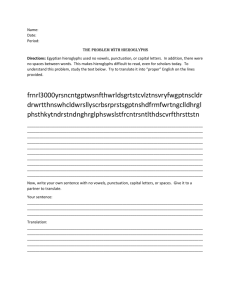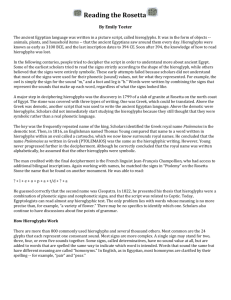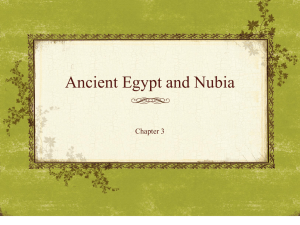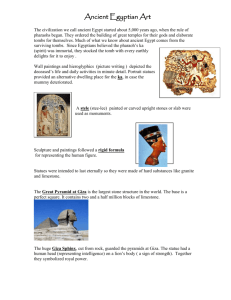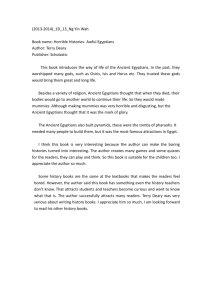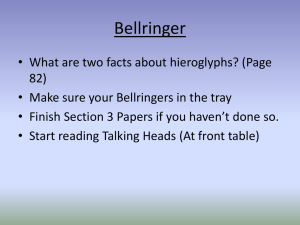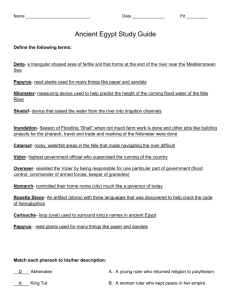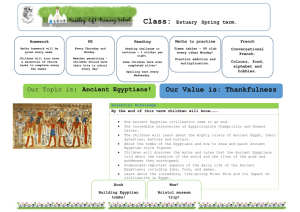Hieroglyphs
advertisement
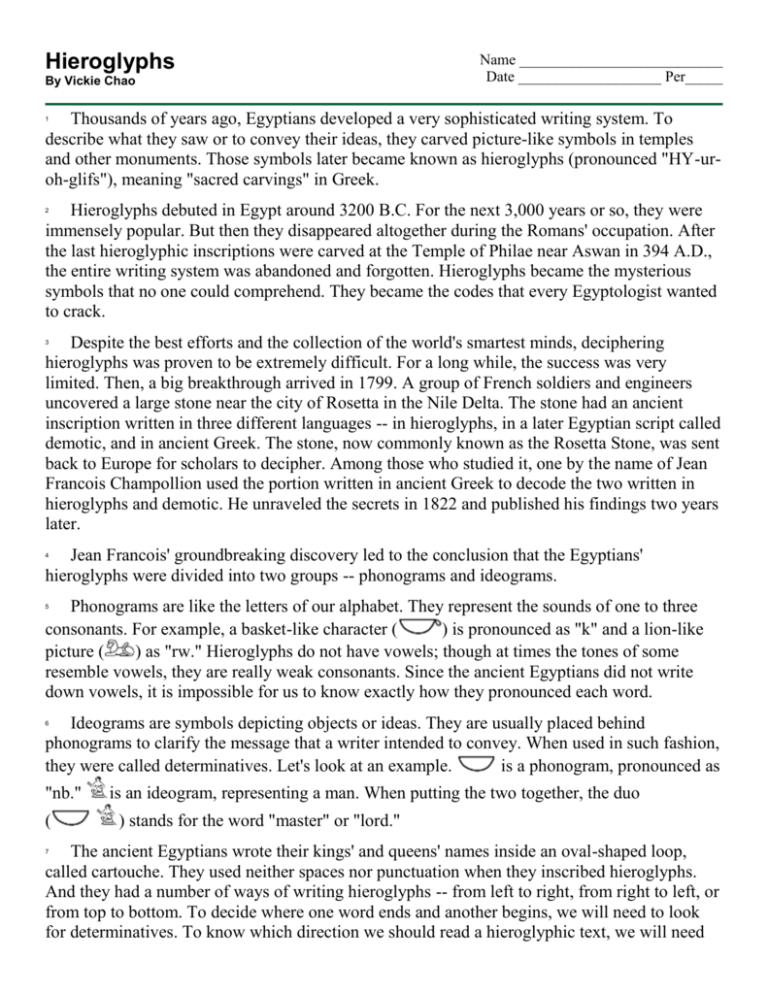
Hieroglyphs By Vickie Chao Name ___________________________ Date ___________________ Per_____ Thousands of years ago, Egyptians developed a very sophisticated writing system. To describe what they saw or to convey their ideas, they carved picture-like symbols in temples and other monuments. Those symbols later became known as hieroglyphs (pronounced "HY-uroh-glifs"), meaning "sacred carvings" in Greek. 1 Hieroglyphs debuted in Egypt around 3200 B.C. For the next 3,000 years or so, they were immensely popular. But then they disappeared altogether during the Romans' occupation. After the last hieroglyphic inscriptions were carved at the Temple of Philae near Aswan in 394 A.D., the entire writing system was abandoned and forgotten. Hieroglyphs became the mysterious symbols that no one could comprehend. They became the codes that every Egyptologist wanted to crack. 2 Despite the best efforts and the collection of the world's smartest minds, deciphering hieroglyphs was proven to be extremely difficult. For a long while, the success was very limited. Then, a big breakthrough arrived in 1799. A group of French soldiers and engineers uncovered a large stone near the city of Rosetta in the Nile Delta. The stone had an ancient inscription written in three different languages -- in hieroglyphs, in a later Egyptian script called demotic, and in ancient Greek. The stone, now commonly known as the Rosetta Stone, was sent back to Europe for scholars to decipher. Among those who studied it, one by the name of Jean Francois Champollion used the portion written in ancient Greek to decode the two written in hieroglyphs and demotic. He unraveled the secrets in 1822 and published his findings two years later. 3 Jean Francois' groundbreaking discovery led to the conclusion that the Egyptians' hieroglyphs were divided into two groups -- phonograms and ideograms. 4 Phonograms are like the letters of our alphabet. They represent the sounds of one to three consonants. For example, a basket-like character ( ) is pronounced as "k" and a lion-like picture ( ) as "rw." Hieroglyphs do not have vowels; though at times the tones of some resemble vowels, they are really weak consonants. Since the ancient Egyptians did not write down vowels, it is impossible for us to know exactly how they pronounced each word. 5 Ideograms are symbols depicting objects or ideas. They are usually placed behind phonograms to clarify the message that a writer intended to convey. When used in such fashion, they were called determinatives. Let's look at an example. is a phonogram, pronounced as 6 "nb." ( is an ideogram, representing a man. When putting the two together, the duo ) stands for the word "master" or "lord." The ancient Egyptians wrote their kings' and queens' names inside an oval-shaped loop, called cartouche. They used neither spaces nor punctuation when they inscribed hieroglyphs. And they had a number of ways of writing hieroglyphs -- from left to right, from right to left, or from top to bottom. To decide where one word ends and another begins, we will need to look for determinatives. To know which direction we should read a hieroglyphic text, we will need 7 to look for symbols with a person or an animal's face. As a general rule, signs representing people or animals all look towards the beginning of the text. Thus, if the signs all face to the left, we should start reading from left to right. Besides relying on hieroglyphs to record their thoughts, the ancient Egyptians also used them for numbers. Numbers are counted in units of 10. The lowest unit is 1 ( ), followed by 10 ( ), 100 ( ), 1,000 ( ), 10,000 ( ), 100,000 ( ), and then finally 1,000,000 ( ). For example, the ancient Egyptians would inscribe to illustrate the amount of 235 and for 310,200. If they had wanted to say they saw two snakes, they would have written the hieroglyphic symbols for snakes first and then the amount of two afterwards. 8 The Egyptian numeric system did not include a decimal point. Decimal numbers were written as fractions. To write 1/5, they would put down a fraction sign ( ) before 5 ( ). Fractions with numerators bigger than 1 were written as a sum of fractions with numerators equal to 1. For example, the ancient Egyptians expressed 2/5 as the sum of 1/5 and 1/5, or . Notably, there are three exceptions to this rule -- 1/2, 2/3, and 3/4. Each of the trio had its unique hieroglyphic symbol. They were never preceded with the fraction sign. 9 Hieroglyphs are a beautiful, original writing system. Nonetheless, they could not withstand the test of time and faded away. Fortunately, all was not lost. Thanks to the discovery of the Rosetta Stone and the genius work of Jean Francois Champollion, we have come to learn a great deal about ancient Egypt and its magnificent civilization! Copyright © 2009 edHelper 10 Hieroglyphs 1. About when did hieroglyphs appear in Egypt? 2,300 B.C. 3,200 B.C. 5,000 B.C. 4,600 B.C. 3. The picture-like symbols used in ancient Egyptian writing were called hieroglyphs which means _________. Phonograms Ideograms Cartouche Sacred Carvings 5. When was the last hieroglyphic text inscribed? 439 A.D. 394 A.D. 934 A.D. 349 B.C. 7. Who unearthed the Rosetta Stone? The Polish The German The Italian The French 2. Which of the following about the Egyptians' hieroglyphs is correct? The Egyptians wrote their kings' and queens' names inside a square. The Egyptians did not have hieroglyphs for numbers. Some symbols represented letters while others depicted objects or ideas. The Egyptians used the sign r to express a fraction. 4. On what did ancient Egyptians write the names of their kings and queens? papyrus cartouche royal scroll temple walls 6. Under whose rule did hieroglyphs disappear? The Arab The Roman The French The Greek 8. Which of the following about hieroglyphs is INCORRECT? The ancient Egyptians did not have hieroglyphic signs for vowels. The ancient Egyptians always inscribed hieroglyphs from left to right. Jean Francois Champollion was the person who successfully deciphered hieroglyphs. The ancient Egyptians did not put fraction sign for the number 2/3.
